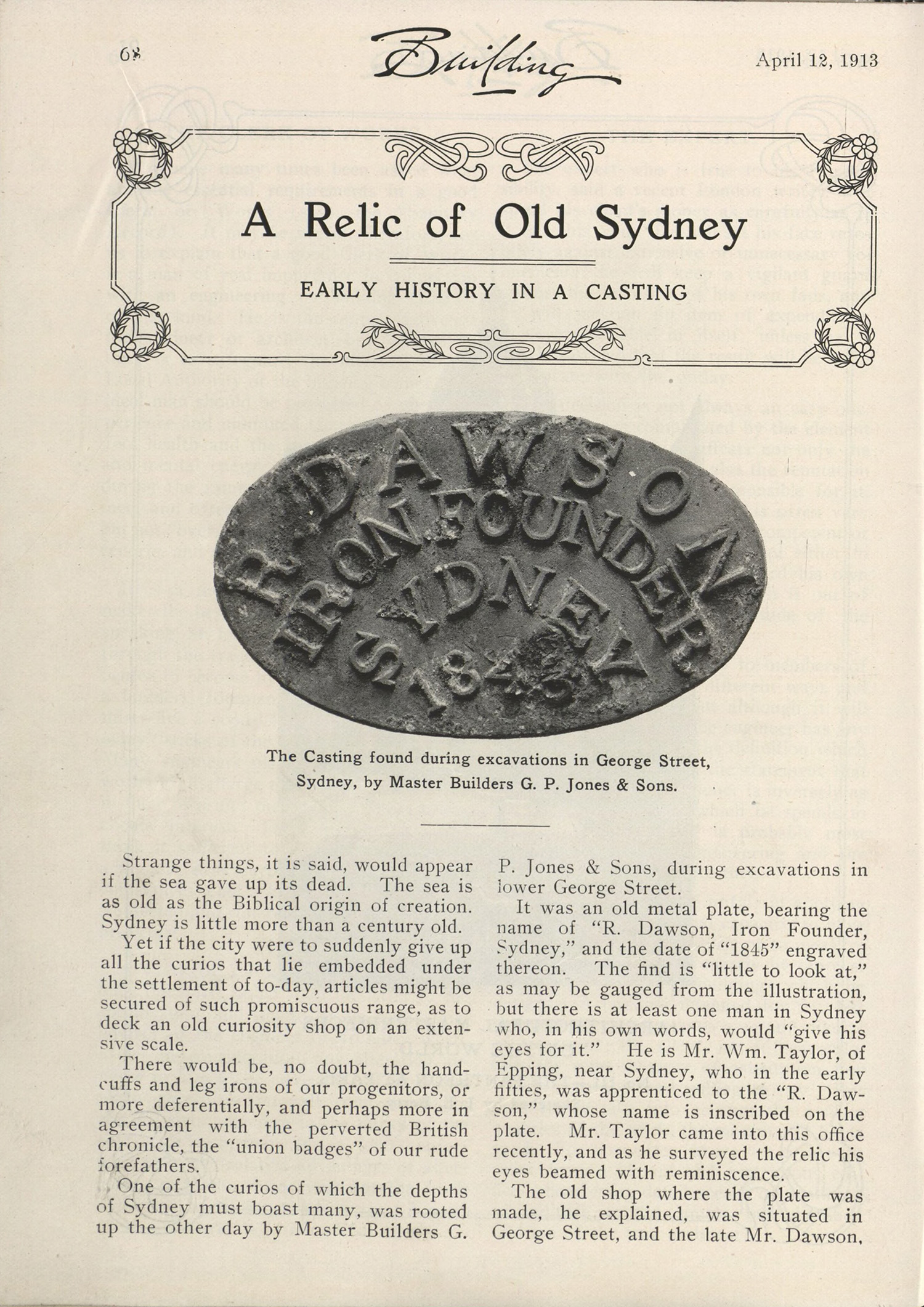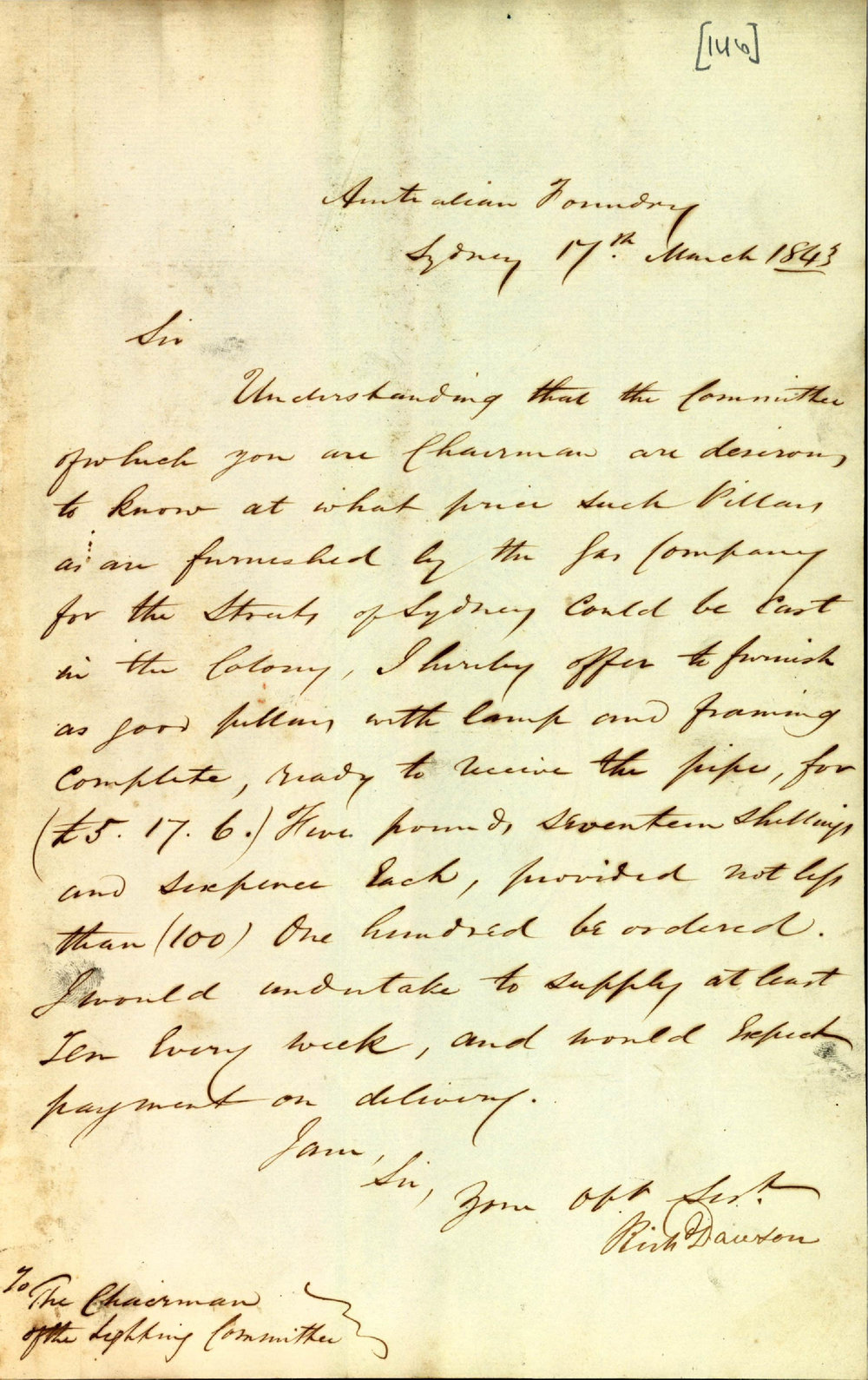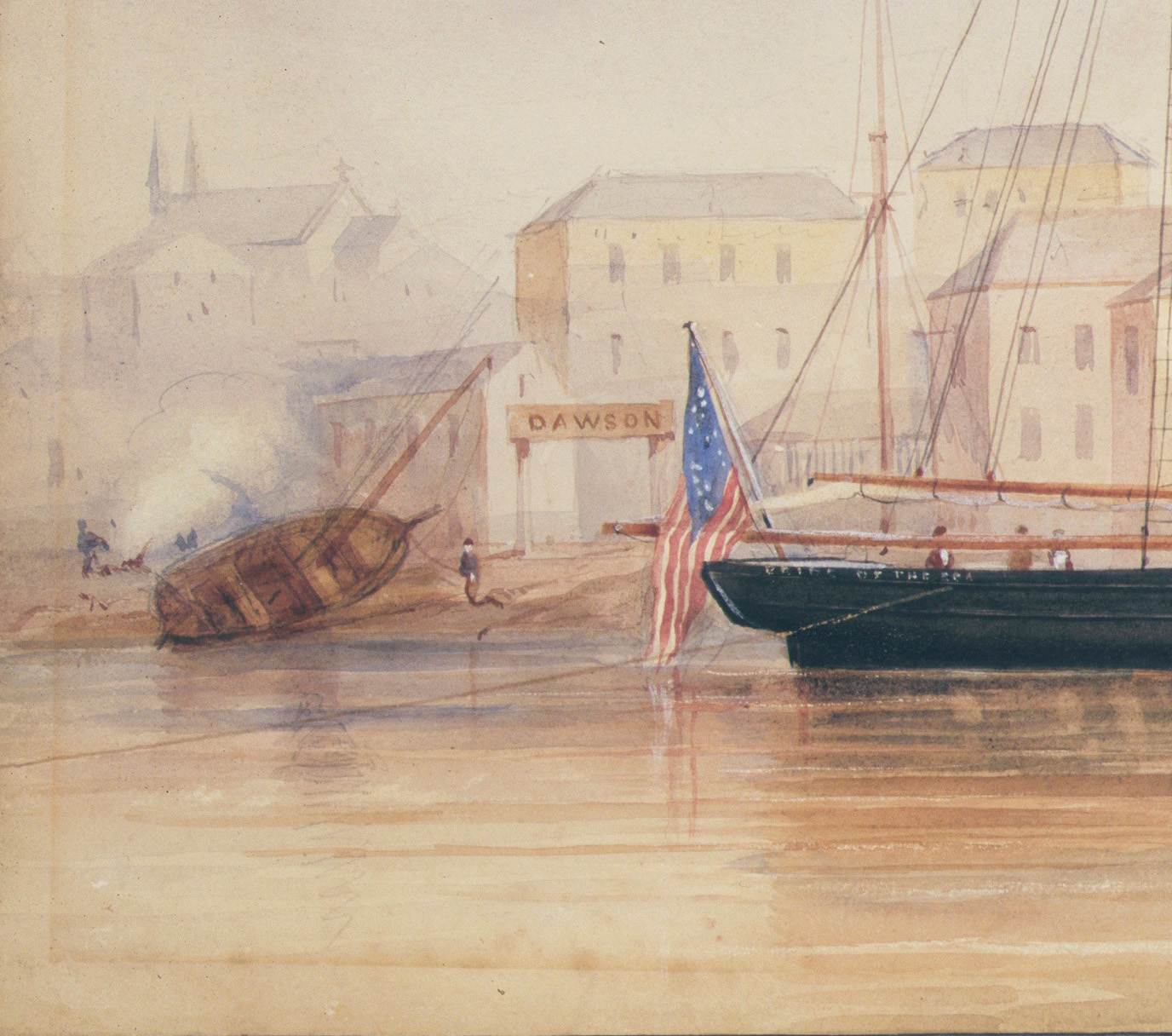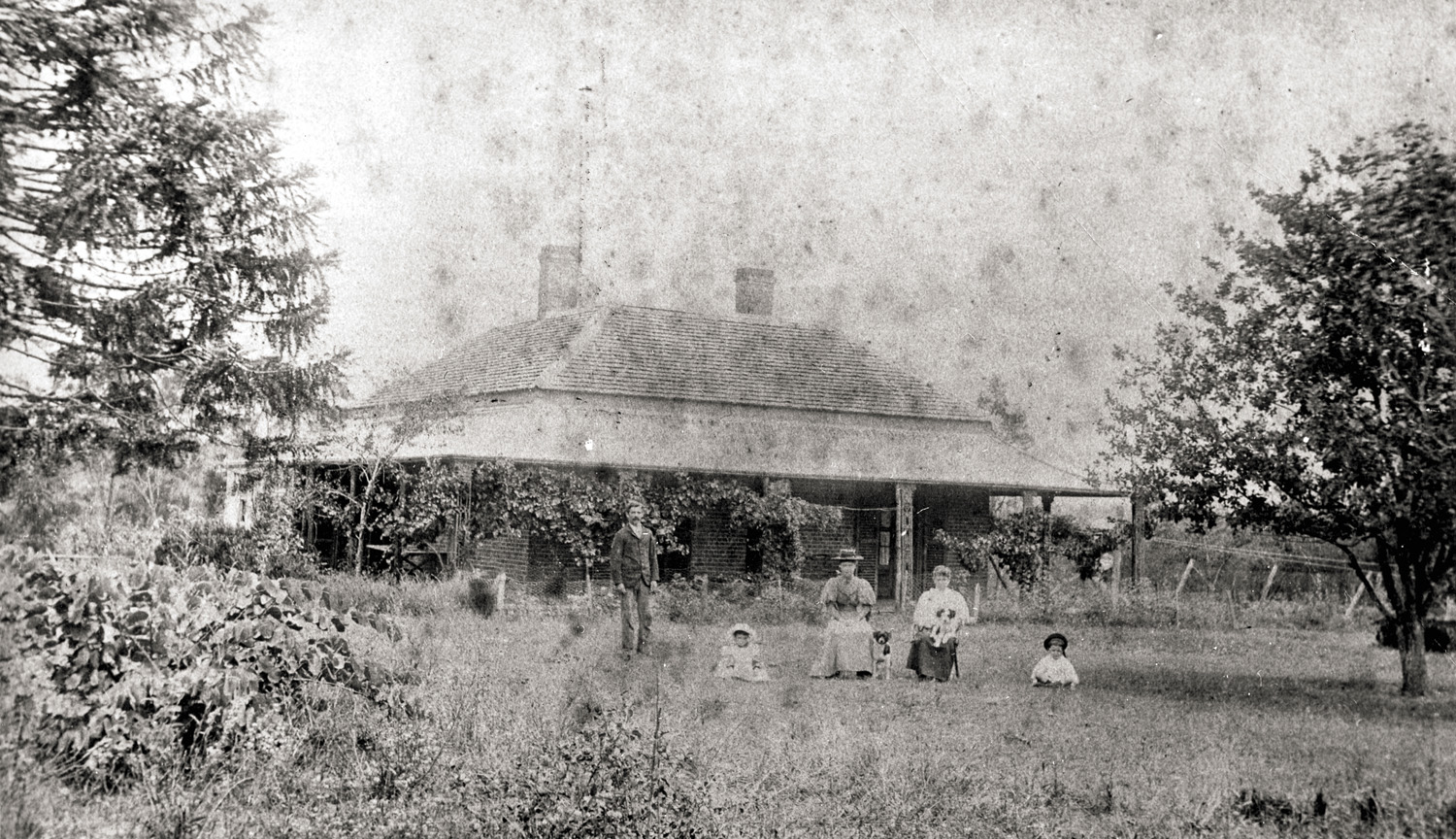The Dictionary of Sydney was archived in 2021.
Richard Dawson's Australian Foundry
Citation
Persistent URL for this entry
To cite this entry in text
To cite this entry in a Wikipedia footnote citation
To cite this entry as a Wikipedia External link
Richard Dawson's Australian Foundry
[media]In 1833 Richard 'Dicky' Dawson established an iron foundry at lower George Street, near Sydney Cove, that quickly became the largest and most important in the colony. [1] Its products were branded 'Dawson', though the foundry was known at various stages as Castle and Dawson, Australian Iron and Brass Foundry, the Australian Foundry, Dawson & Co and Dawson's Foundry. It operated for nearly forty years, closing six years after Dawson's death. It was a city landmark, constantly referred to in press reports and everyday town talk, and a site of innovation and technology transfer.
The Australian Foundry site
[media]From 1833 until 1872 Richard Dawson's iron foundry occupied a parcel of leased land facing lower George Street to the west and Sydney Cove to the northeast. When land was reclaimed in the 1850s for the development of Sydney's Semi-Circular Quay (as it was then known) the foundry's eastern frontage then became New Pitt Street. The foundry site occupied approximately 7,000 square metres and contained Dawson's 12-room, two-storey stone and slate house and store, which fronted 622 Lower George Street. These premises were later renumbered as 186 George Street. [2]
Dawson arrived in the colony in 1833 and immediately established a ship smith business on the western side of George Street in The Rocks. [3] From January 1834 he joined Henry Castle in his blacksmith and ship and anchor smith business close by. [4] In early 1835 Castle and Dawson, as their business was styled, moved to the larger site on the eastern side of the street, which enjoyed a water frontage to the cove. Dawson bought Castle's share in January 1837 when Castle returned to England. [5] The business continued as the Australian Foundry until Dawson's death in 1865, when it became Dawson and Co.
Sydney's first important iron foundry
Products crafted by Dawson's blacksmiths and founders, along with a wide range of imported iron and iron goods, were sold in Dawson's George Street store. Wares included household and construction items such as verandah supports, sash-weights, tools, rivets, nails, grates and stoves along with marine ironware comprising pumps, bells, iron chains, anchors, tanks, cast-iron winches and cooks' hearths. [6] Wool presses, weighing machines, corn mills, threshing machines, boiling-down pots, soap pans, sugar pans, and guns were fabricated. [7] The factory also made seamarks that included iron buoys and lighting apparatus, such as the floating light at the Sow and Pigs Shoal near the entrance to Sydney Harbour and the Gellibrands Point and Shortland Bluff Lighthouses at Port Phillip in Victoria. [8] The foundry expanded in size and capacity to cast a diverse range of high quality iron products and built a steam engine that has been described as 'a marvel of mechanism'. [9] Ship repair and engineering work became increasingly important – in 1837 the Rapid , a prefabricated 44-ton (39.5-tonne) iron steam boat, was assembled at the wharf on the Sydney Cove frontage of Dawson's Foundry, and was described by the Sydney Herald as 'the wonder of iron swimming'. [10]
[media]The survival of the foundry was jeopardized in 1843 when Richard Dawson became insolvent. In 1842, a time of severe depression, Dawson lost money to 15 of his creditors, was heavily indebted to banks, owed a large amount to a British supplier of marine equipment and was committed to the build of a new 240-ton (217.7-tonne) ship that he jokingly referred to in his insolvency papers as the Insolvent. [11]
Dawson quickly got back on his business feet, owing to an understanding landlord, his ability to borrow and buy back his assets in the depressed market, and his gregariousness, honesty and recognised integrity. The Australian Foundry and its store, co-located with Dawson's house and counting house, soon again became a go-to destination for ship owners, captains, and agents. Foundry employees conducted ship repairs at the foundry wharf, or at anchor in the harbour, and supplied equipment and provisions.
[media]Dawson also acted as a shipping agent and hosted ship captains, who sometimes stayed at the Dawson residence while their ships were in port, perhaps playing billiards with Dawson and enjoying musical evenings, attended by his servants. [12] Occasionally the wives of visiting captains gave birth at the house. [13] The Dawson 'destination' was announced in George Street by a lead plaque, now in the collection of the Powerhouse Museum, and by a large DAWSON sign that faced the waters of Sydney Cove, close to where it was entered by the waters of the 'Stream of the Tanks' (the Tank Stream).
Iron and coal for the foundry
Dawson introduced iron-casting, which led to a dramatic leap forward in business activity, but production was limited by the scarcity of the raw materials of iron and coal for the furnaces. Essentially, foundry work involved melting imported pig iron, and some imported and local scrap, and casting it in moulds made by pattern makers to create the iron products demanded in the colony.
Sourcing reliable supplies of good quality iron and coal posed problems for the Australian Foundry. No iron was produced locally until 1848 when the first output of the Fitzroy Ironworks at the optimistically named New Sheffield (Mittagong, NSW) became available. [14] Unfortunately, both supply and quality were unreliable and the colony remained dependent on imported iron.
The coal that fuelled the blacksmiths' fires and iron-melting furnaces at Dawson's Foundry came from Newcastle. To ensure a reliable supply Dawson moved toward vertical integration of his iron business, buying and operating ships to ferry coal from Newcastle to Sydney Cove, sometimes in partnership. These ships were typical in size of purpose-built or adapted coal-carrying 'coasters' of the day but were small, even tiny, by later standards. The first, and smallest, of these Dawson-owned vessels was the 28-ton (25-tonne), single-masted sloop Vulcan, built on the Manning River for Dawson and launched in September 1837. This first venture into coal-shipping was short-lived, as the Vulcan was wrecked with the loss of all six crew members, just three months later at the entrance to Newcastle Harbour. [15] The vessel's replacement, the 87-ton (79-tonne) Rover, part-owned briefly by Dawson, brought coal down from Newcastle until 1841, when she was lost in a furious gale at Broulee on the south coast, 'deeply laden' with convicts and coal, en route to Port Phillip. [16] Carrying coal was proving expensive in human as well as business terms.
Left without a foundry coal-supply vessel, Dawson turned to his 49-ton (44.5-tonne) schooner Rover's Bride, 'one of the smartest traders on the Australian coast'. [17] Dawson had operated this vessel as a coaster for voyages along the New South Wales coast, to Port Phillip and Geelong, Launceston and the Swan River. The vessel had, under charter and with 25 men on board and 'armed to the teeth' [18], voyaged to Valparaiso in Chile, via New Zealand and Tahiti, in pursuit of a fraudster. In 1841 and 1842 the Rover's Bride travelled a triangular route from Sydney to Newcastle and the Dawson-owned farming settlement and whaling stations on Lord Howe Island, shipping coal and carrying supplies. [19] Other Dawson-owned ships followed, among them the 91-ton (82.5-tonne) schooner Anna Maria that made over 100 coal-carrying journeys from 1849 until 1851, when she was lost on Newcastle beach in 1851 while laden with coal bound for Dawson's Foundry. [20] During 1853 Sea Gull carried coal on Newcastle-Sydney journeys and then in 1854 and 1855 the 35-ton (31.75-tonne) schooner Agnes Napier made at least 25 of these coal-fetching voyages before being wrecked and lost. [21]
Pioneer engineering work
The Australian Foundry engaged in a wide range of engineering work, helping to solve problems with machinery that was half a world away from its place of manufacture, such as repairs and improvements to a printing press, mill equipment and irrigation equipment for Sir John Jamison's Penrith vineyard. [22] The foundry manufactured its own steam engines but also repaired imported engines and those of visiting steamships, as well as making emergency repairs to ship hulls. [23] Marine work dominated the foundry's production, but later engineering work included work on cannon and guns, the manufacture and repair of quartz-crushing and amalgamating machines for goldfields, construction of a steam drilling machine to excavate the basin of Wollongong Harbour, cast iron pipes and gutters for City of Sydney Council and eave gutters for the George Street markets. [24]
Men and machines
Contemporary newspaper advertisements reveal that Dawson's Foundry employed pattern makers, shipsmiths, blacksmiths, copper smiths, braziers, bellows makers, moulders, carpenters, bricklayers, furnace men, firemen, engine men, hammer men, chippers (to clean castings), dressers, boiler makers, riveters, fitters and engineers, letter cutters (for cutting brands), coal carriers, draymen, carters, labourers and errand boys. Foremen and office clerks supervised activities. Some of the numerous apprentices slept in the hayloft above the foundry stables and barn and workers lived alongside pigs, goats and hens that scavenged in the yards and sheds and helped feed the Dawson family and their maritime guests. [25] Employees also enjoyed the company of the foundry's numerous dogs and, at one time, a pair of black swans. [26]
In early 1865 the foundry employed 51 men and boys. [27] In 1866 the foundry was manufacturing patent windlasses, deck and mast winches, ship's cabooses, iron pumps, hawse and deck pipes, iron blocks, guns and shot, mills, steam engines, hydraulic presses, screw presses, crab winches, quartz crushing machines, stampers and all duplicate castings, cast and wrought iron ornamental railing, plain and fluted columns, pilasters for cottages, iron gates and sink traps. [28] By 1868 the workforce comprised 75 men and boys, and the foundry had a fitting workshop with machines for metal boring, turning, planing, punching and shearing and a large screw-cutting machine. This machinery was worked by a 12-horsepower (8,950 watt) steam engine. In the nearby moulding works were three cupolas capable of casting up to 18-tons (16.3-tonnes). A separate smiths' workshop boasted four smithy fires and two furnaces. [29]
In a time when safety provisions for workers were minimal, serious accidents occurred at the foundry. Press reports told of a worker's leg being amputated after it was caught in the crank of a steam engine, fingers amputated from a crushed hand, and another worker's leg broken by a cogwheel. [30]
The pounding steam engines and belt-driven machinery, as well as the constant din of hammering and riveting, made Dawson's Foundry a noisy place. Its coal fires polluted the air and its waste polluted the stream and cove into which it flowed or was dumped. At night the glow from the furnaces lit up the sky and the adjoining waterfront - so much so that, on at least one occasion, horse-drawn fire appliances, rushing to respond to an 'alarm of fire', arrived to find the glow was from the foundry's night work. [31]
Direct and spillover technology transfer
Dawson's Australian Foundry served as an important conduit for the transfer of the iron casting and engineering technologies of England's industrial revolution to the colony of New South Wales. Dawson brought his own experience, gained in and around Bristol in England, as did many hundreds of the men he employed. Dawson also devoted considerable energy to innovation and imported machinery to copy (sometimes under licence) and improve, including winches, steam engines and quartz crushing machines. Some of the earliest steam engines manufactured in the colony were products of the Australian Foundry. Dawson and his staff pored over imported books and newspapers that detailed products and manufacturing processes, and imported designs and patterns. Dawson, occasionally working with partners, collaborated in casting and engineering projects, advancing technology in ship repair, steam engine design and manufacture, and metal machining and finishing. With Eugene Dominique Nicolle, Dawson and his engineers at the foundry invented and patented pioneering ice-making machinery. [32]
It is a measure of the success of the foundry's role in importing and adapting new iron casting and machine technologies that, by 1859, Dawson could advertise that there was nothing imported in his extensive range of mill machinery, steam engines, hydraulic and screw presses, crab winches, quartz crushing machines, stampers, butchers' chopping and filling machines, ornamental railing, plain and fluted columns, pilasters for cottages, iron gates and sink-traps. [33]
As well as direct technology transfer, the work of the Australian Foundry inevitably led to spillover technology transfer, as foundry workers moved on to other iron trade businesses or went into business of their own. Spillover transfer also occurred when visitors were invited to witness large scale pourings of iron, to see machinery in operation and to observe the operation of the foundry's daily work. [34] Richard Dawson's Australian Foundry was a key presence in Sydney's first industrial area because of its adaptation of processes and products and its work in improvisation and innovation. It helped transform the Sydney Cove and Cockle Bay area into the colony's pioneer research and development park.
End of an era
Richard Dawson died in June 1865 and his widow sold the business, then known as Dawson & Co, to Thomas Sutcliffe Mort in 1872. [35] Mort briefly advertised the site as the 'Town Branch' of his Balmain works. [36] However Mort transferred the machine tools to Balmain and closed the foundry. [37]
Surviving castings
[media]A number of castings from Dawson's Foundry survive. Gundagai Historical Museum, Land of the Beardies History House Museum at Glen Innes, Saumarez Homestead Museum at Armidale and the Davidson Whaling Station at Twofold Bay and the Australian Stockman's Hall of Fame at Longreach in Queensland all hold cast iron boiling-down pots, or tallow pots, that bear Dawson's maker's mark. Sydney's Pitt Street Uniting Church (the former Congregational Church) has elaborately fluted columns cast at Dawson's in 1845, and which remain in fine condition. Decorated verandah posts cast at Dawson's Foundry that date from the 1850s survive at Mills Cottage, at Port Fairy in Victoria, and Hebe, the country farm house Richard Dawson built for his retirement at Schofields in western Sydney. Also surviving in situ, and again showing the Dawson maker's mark, are a number of cannon pivots at the 1801 fort near Obelisk Point at Middle Harbour. Only a photographic record survives of the copper plaque made at the foundry for Richard Dawson's cast iron burial vault at Camperdown Cemetery.
References
Percy Adams. A Brief History of a Branch of the Dawson Family of Dysart and Kirkcaldy Co Fife (1690-1840). Stoke-on-Trent: Wood Mitchell, 1952.
Harry Irwin. 'Richard Dawson: Colonial Ironmaster, Engineer, Merchant and Agent of Technology Transfer.' Journal of the Royal Australian Historical Society, 97, 2, 2011.
Notes
[1] This was a claim made about 100 years later at the time of the opening of the Sydney Harbour Bridge when there was sharpened interest in the iron trades, 'Richard Dawson, Our First Ironfounder', Sydney Morning Herald, 2 July 1932: 9
[2] City of Sydney Assessments, for example 1845, 1851, 1861
[3] Percy Adams, A Brief History of a Branch of the Dawson Family of Dysart and Kirkcaldy Co Fife (1690–1840) (Stoke-on-Trent: Wood Mitchell, 1952): 5; Sydney Herald, 24 April 1833: 3; Australian Almanack and Sydney Directory 1834
[4] Sydney Gazette and New South Wales Advertiser, 7 January 1834: 1
[5] Sydney Herald, 12 January 1837: 4
[6] R Irving, The History and Design of the Australian House (Melbourne: Oxford University Press, 1985): 78; Sydney Gazette and New South Wales Advertiser, 22 February 1834: 1; The Australian, 28, April 1834: 1; Sydney Herald, 7 August 1834: 1; Australian Almanack and General Directory, 1835; Sydney Monitor, 14 March 1835: 1; B Evans, 'Engineering in New South Wales One Hundred Years Ago', The Metal Trades Journal, 2 August 1948: 191; Sydney Morning Herald, 5 November 1845: 3
[7] Business bill-head (invoice) dated 30 June 1838 issued by Dawson's Foundry, 'Ship & House Smith', Riley Papers, CY Reel 100, Mitchell Library; The Australian, 5 August, 1834: 3; Morning Chronicle, 3 February 1844: 1; Sydney Morning Herald, 22 March 1844: 3
[8] Harry Irwin, 'Richard Dawson's Lights', Prism: Journal of the Australian Lighthouse Association, 4, 2012; New South Wales-Governor's Despatches by the Secretary of State for the Colonies, 28, 1837: 146; House of Commons, 'Returns Relating to Lights and Lighthouses in the British Colonies', in Accounts and Papers, Session 31 January 1850–August 1850, 1, 3, 110/566; 'Port Phillip Lighthouse', Sydney Morning Herald, 25 November 1842: 2.
[9] 'Newcastle Breakwater', Sydney Monitor, 13 June 1835: 2; Norman Selfe, Annual Address to the Engineering Section of the Royal Society of New South Wales, June 20 June, 1900: 13
[10] Sydney Gazette and New South Wales Advertiser, 14 December 1837: 2
[11] State Records of New South Wales, Supreme Court of New South Wales, Registrar in Bankruptcy, NRS 13654, Insolvency files, 1842–87, Richard Dawson, 5 August 1843, Document 848
[12] Sydney Morning Herald, 21 April 1843: 3; Sydney Morning Herald, 3 May 1850: 2; Empire, 3 October 1856: 4. In the early life of Dawson's Foundry, household servants were assigned convicts. New South Wales Government Gazette, 24 October 1838: 891; New South Wales Government Gazette, 12 February 1841: 245. Later, they were employed following newspaper advertisement, for example, Sydney Morning Herald, 15 August 1851: 1; Sydney Morning Herald, 16 April 1863: 8
[13] For example, Sydney Monitor, 10 May 1839: 3; Sydney Morning Herald, 8 July 1846: 3
[14] R Else-Mitchell, Early Industries in the Mittagong District (Berrima Historical Society, 1981); B. McKillop, Furnace, Fire and Forge (Surrey Hills, Victoria: Light Railway Research Society of Australia, 2006): 15–20
[15] P Stone, Encyclopedia of Australian Shipwrecks and Other Maritime Incidents (Yarram, Victoria: Oceans Enterprises, 2006): 947; C Bateson, Australian Shipwrecks (Sydney, Reed, 1972): 130; 'Loss of the Cutter 'Vulcan' and Six Lives', Sydney Monitor, 27 December 1837: 2. In total eight lives were lost, if the deaths of two crew of a pilot vessel attempting to assist the stricken vessel are included in the count.
[16] Vaughan Evans Research Library, Australian National Maritime Museum, Ships Registered in Australian Ports, 1841/029, Reel C1/01; 'The Wreck of the Rover', Sydney Herald, 25 October 1841: 2
[17] A Portus, 'Early Australian Steamers, Period 1831–1856', Journal and Proceedings of the Australian Historical Society, 2, 9, 1904: 183
[18] The Sydney Gazette and New South Wales Advertiser, 24 October 1839: 2
[19] For example, Australasian Chronicle, 21 January 1841: 3; Sydney Herald, 27 August 1841: 2; Sydney Herald, 22 January 1842: 2; Sydney Herald, 22 June 1842: 1
[20] Maitland Mercury, 30 August 30, 1851: 2.
[21] Figures derived from issues of the Maitland Mercury, 1853–1855
[22] The Sydney Gazette and New South Wales Advertiser, 11 November 1834 wrote in praise of the work done at the foundry (Castle and Dawson's) to improve its printing press and noted that, 'These gentlemen have…offered to give a warranty they will make a press equal to one by CLYMBER or COPE, for less than it can be imported at.'; 'Necessary alterations' to 'extensive [irrigation] equipment' imported by Sir John Jamison for use in his vineyard at Penrith, near Sydney, Sydney Gazette and New South Wales Advertiser, 1 January 1, 1835: 2; Sydney Gazette and New South Wales Advertiser, 9 May 1837: 4; Letter from Richard Dawson to the Editor, Sydney Morning Herald, 13 August 1842: 2
[23] Castle and Dawson's 'Colonial Manufactured Steam Engine' powered their foundry, Colonist, 24 September 1835: 8; a 20 horsepower (14,914 watt) engine manufactured at the foundry powered a corn mill at Windsor, Sydney Gazette and New South Wales Advertiser, 30 June 1835: 3; Dawson's Foundry produced a 43-inch [110cm], 30cwt [1.5-tonne] cylinder cast for the engine of the SS Tasman, Norman Selfe, Annual Address to the Engineering Section of the Royal Society of New South Wales, June 20 June, 1900; G Linge, Industrial Awakening: A Geography of Australian Manufacturing, 1788–1890 (Canberra: Australian National University, 1990); The factory made a 4-ton [3.6-tonne] cylinder cast for the engine of the Prince Alfred, New Zealand Herald, 29 August 1866: 3
[24] For example, two six-pound [2.7-kilogram] guns for the steamer Corsair. RC Solomon, The Convicted Gunsmiths of New South Wales (Rockdale, Sydney: Solomon, 1999): 22; The Australian, 8 November 1845: 2; Goulburn Herald, 9 April 1859: 1; Sydney Morning Herald, 15 January 1862: 4; Sydney Morning Herald, 24 May 1866: 3; Sydney Morning Herald, 21 August 1862: 8; Letter from the City Engineer to Mayor (Sydney) regarding contracts for supply of castings to the City Council for 1862, City of Sydney Archives, Letters Received, Container 43502, 28 February 1862; Sydney Morning Herald, 28 May 1862: 3; City of Sydney Archives, Report of the Committee on Tenders for Guttering and Piping for George Street Markets, 1845, Document 21/003/109 (219), Box CSA 047 185
[25] Various newspaper employment advertisements; See also Sydney Gazette and New South Wales Advertiser, 31 July 1838: 3; Sydney Herald, 12 November 1840: 3
[26] Sydney Morning Herald, 5 September 1853: 1
[27] 'The Iron Trades', Sydney Morning Herald, 21 March 1865: 6
[28] The Illustrated Sydney News Saxby Almanac for 1866, Advertising Section: 23
[29] 'The Manufacturing Industry of New South Wales, No. XIV, The Iron Trade', Sydney Morning Herald, 21 August 1868: 5
[30] Sydney Gazette and New South Wales Advertiser, 13 May 1848: 3; Australian Home Companion and Band of Hope Journal, 9 March 1861: 2; Freeman's Journal, 3 August 1861: 2
[31] 'Alarm of Fire', Empire, 30 May 1861: 5
[32] 'Parliamentary Paper, Patents', Sydney Morning Herald, 25 January 1864: 3; Sydney Morning Herald, 7 June 1889: 3; Mitchell Library, ED Nicolle – pictorial collection, ca. 1845, 1869–1874, A 2750 and A 2751, letter written By Eugene Dominic Nicolle acknowledging Dawson's work on this project
[33] Maitland Mercury, 19 March 1859: 1; Goulburn Herald, 9 April 1859: 1
[34] For example, at the casting of a 32 cwt [1.63-tonne] soap pan 'the largest, as well as the heaviest casting ever made in this colony', Sydney Herald, 2 June 1842: 2; and a 28 cwt [1.42-tonne] soap pan measuring 22 feet [6.7 metres] in circumference and four feet [1.2] in depth. 'Domestic Intelligence…Manufactures', Sydney Herald, 18 October 18, 1841: 2; Governor Bourke visited to inspect a new buoy. Sydney Gazette and New South Wales Advertiser, 15 March 1834: 2; Bourke viewed iron samples from the Fitzroy Mine, G Abbott and G Little, The Respectable Sydney Merchant: AB Sparke of Tempe (Sydney University Press, 1976); See also 'Stephen's Patent Battery', Empire, 12 August 1871: 2
[35] Sydney Morning Herald, 8 March 1872: 8
[36] Evening News, 1 June 1872: 3
[37] Keith Murray, 'A History of Mort's Dock and Engineering Co Ltd', The Australian Naval Architect, 6, 2002







